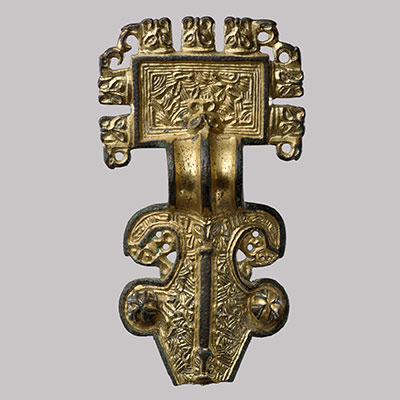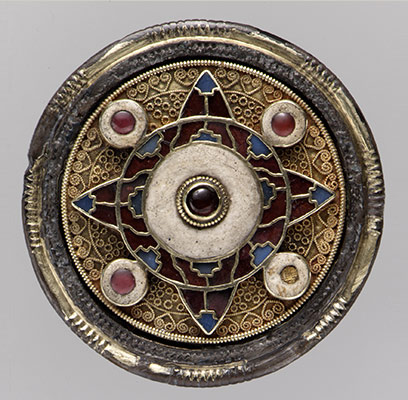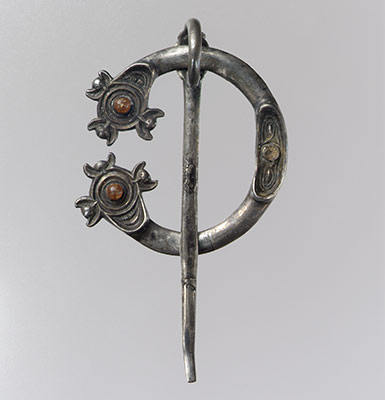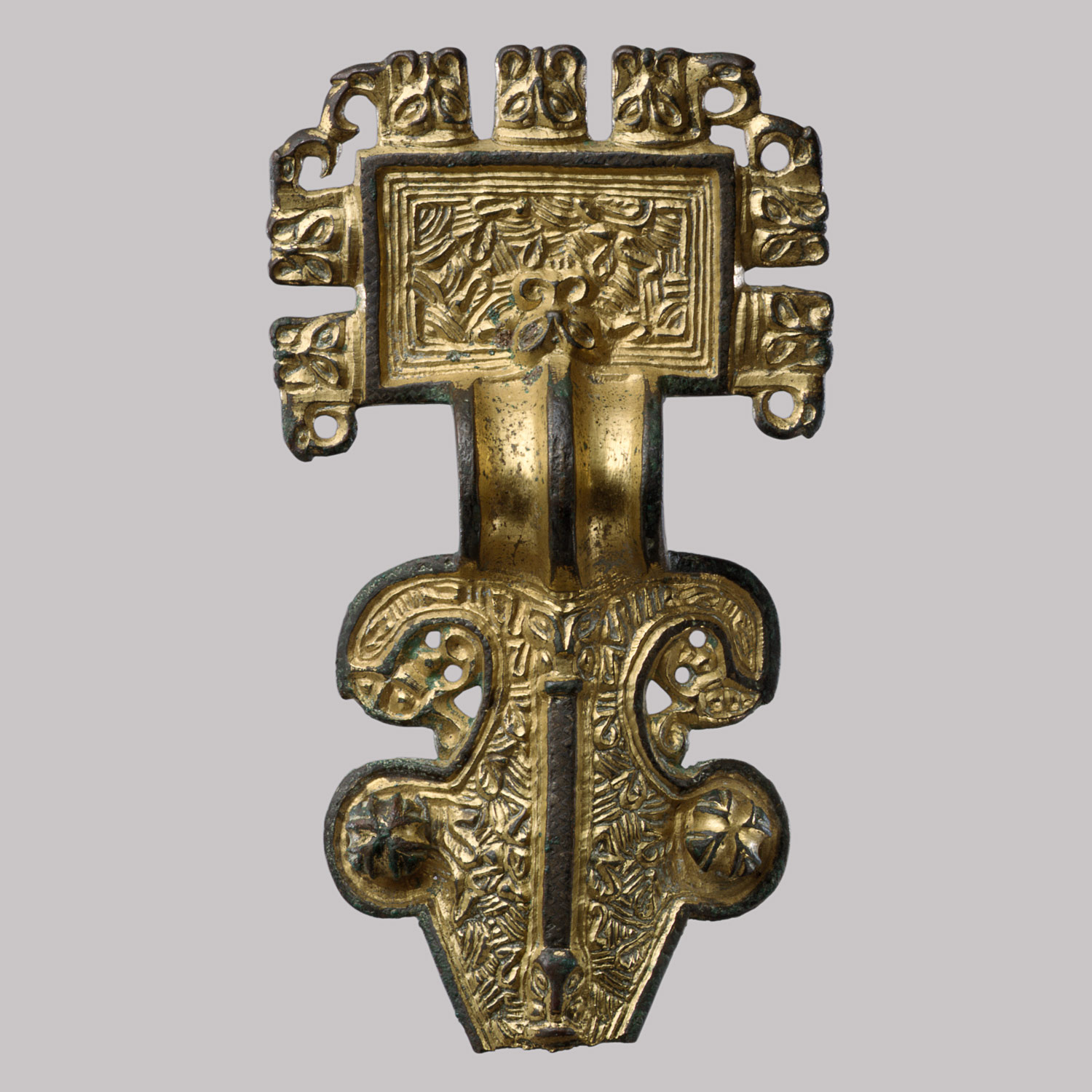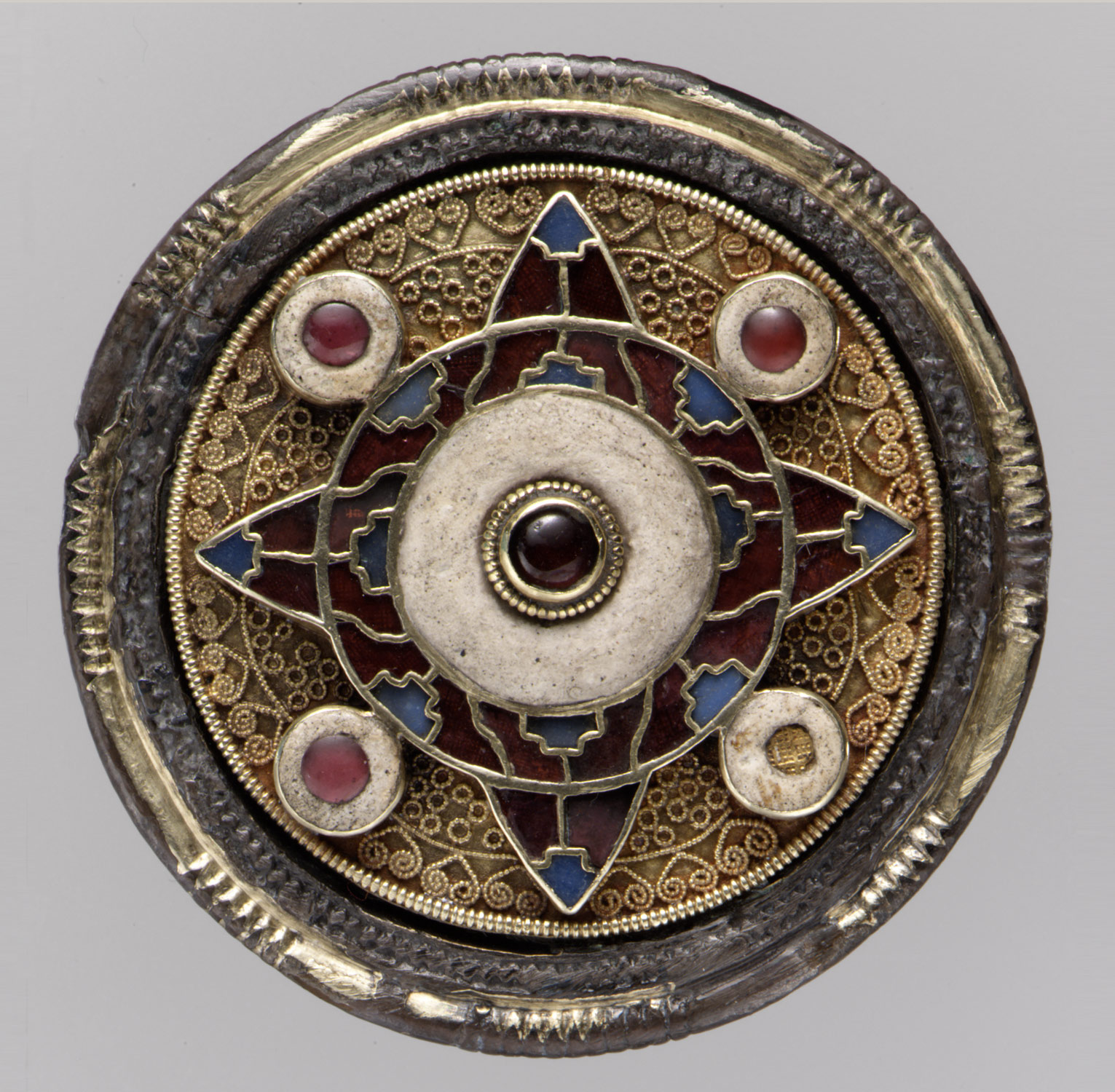In this period, the lands now known as England, Ireland, Scotland, and Wales are subdivided into smaller regions, each of which is governed by a territorial king. They are in constant contact and conflict with one another, frequently clashing over issues of land ownership and power. Often, rulers display their wealth and prominence by wearing splendid golden and jeweled brooches as marks of their status. During the fifth and sixth centuries, Christianity flourishes in Britain, especially in the monasteries, which become centers of learning and literacy. Indeed, a great deal of contemporary artistic production is linked to the Church, for example, elaborately decorated liturgical vessels for use in Mass, and fine illuminated manuscripts. There are also many surviving examples, especially in Ireland, Scotland, and Wales, of monumental sculptures, in particular, massive, carved stone crosses.
Great Britain and Ireland, 500–1000 A.D.
Timeline
500 A.D.
625 A.D.
ENGLAND
WALES
SCOTLAND
IRELAND
625 A.D.
750 A.D.
ENGLAND
WALES
SCOTLAND
IRELAND
750 A.D.
875 A.D.
ENGLAND
WALES
SCOTLAND
IRELAND
875 A.D.
1000 A.D.
ENGLAND
WALES
SCOTLAND
IRELAND
Overview
Key Events
-
410
The Roman legions leave Britain. In an effort to protect themselves, the Romano-Briton kings invite in Germanic tribes such as the Angles and Saxons. Revolt by these mercenaries results in large Germanic settlements in southeast England. Germanic advances are temporarily halted by the native Britons at the Battle of Mons Badonicus in 500, but Germanic tribes return in force in 550.
-
461
Saint Patrick arrives in Ireland, and much of the country is converted to Christianity.
-
563
Saint Columba of Ireland arrives on the western Scottish island of Iona and founds a monastery there. He and his followers travel through Scotland and Northumbria, converting the native Picts and Celts to Christianity. He also brings with him the artistic tradition of his former monastery, Lindisfarne, where the justly famous illuminated Lindisfarne Gospels are later created (ca. 698–721). These include Christian figural imagery with Mediterranean-inspired iconography, as well as brilliantly colored abstract geometric designs.
-
597
Saint Augustine (not to be confused with the fifth-century church father) is sent to England by Pope Gregory, where he becomes a great force for conversion and the first archbishop of Canterbury. Kent is the first kingdom to become fully Christian.
-
ca. 625
The Sutton Hoo ship burial (British Museum) is interred around this time, a rich array of objects buried inside a wooden ship, under a mound. Although no body has been found (perhaps due to soil acidity), many fascinating grave goods have been recovered, including an iron helmet decorated with tinned bronze foil appliqués, gold buckles inlaid with niello, and a purse cover adorned with cloisonné enamel. Coins found among the grave goods help to date it; many of the objects appear to have originated in Anglo-Saxon workshops. The find is associated with Raedwald (d. 625), king of East Anglia, who converted to Christianity but then returned to paganism. This would explain the pre-Christian burial style, with grave goods and a barrow tomb.
-
664
The Synod of Whitby is held in England. It deals with the liturgical conflicts between the Celtic and Roman branches of Christianity, both of which have a strong presence in Britain. Eventually it is decided to conform to the Roman church, bringing England into a much-needed closer alliance with Rome and Continental Europe. The Celtic church will continue to figure strongly for some time in Welsh, Irish, and Scottish history, but eventually these countries, too, will go over to Rome.
-
731
The Venerable Bede, a great English scholar and monk, writes his Ecclesiastical History of the British Islands. It is a thorough history of the early medieval period in the British islands that pays particular attention to the growth of Christianity. The Old English poem Beowulf, with its roots in earlier Norse sagas, may have been recorded around this time, as are the poems of Cynewulf.
-
ca. 795
The Vikings land on Iona, pillaging the monastery and settlement there. By the mid-ninth century, they have settled in many parts of Ireland and Scotland, where they will prove a lasting influence on warfare, social structure, language, and art. In particular, Scandinavian interlace decoration exerts a strong influence on painting, sculpture, and metalwork. This can be seen clearly in the later, twelfth-century Cathedral of Saint Magnus in Scotland, built in Kirkwall by Ragnvald, the Norse earl of Orkney, in memory of his uncle, the titular saint.
-
ca. 800
The Book of Kells (Dublin, Trinity College) is created, perhaps at the Irish monastery at Iona. Considered a masterpiece of Hiberno-Saxon art, the book is filled with full-page illuminations of breathtaking complexity and intricate interlace patterning that calls to mind the precision of metalwork. Giraldus Cambrensis, who saw the manuscript in Ireland in the twelfth century, describes it as “so delicate and subtle, so exact and compact, so full of knots and links, with colors so fresh and vivid that you might say that [it] was the work of an angel.”
-
871–899
Alfred the Great is the king of Mercia and Wessex. During his reign, invading Danish armies colonize areas of north, central, and eastern England, which become known as the Danelaw. Alfred holds off the Danes successfully in his own kingdom, and also encourages an important period of learning. One of his innovations is the Anglo-Saxon Chronicle, a historical record of the times that begins in his reign and continues in one version until 1155. He also orders the creation of objects like the Alfred Jewel (Oxford, Ashmolean Museum), a cloisonné ornament inscribed with his name and probably intended as a scepter top.
-
924–939
King Aethelstan is the first ruler to call himself “king of all Britain” on some of his coinage, by which he means modern-day England, Scotland, and Wales. It is uncertain whether he actually received homage or tribute from the latter two countries.
-
ca. 940
A great reformation of the church begins, mirroring similar events on the Continent, resulting in the commision of many manuscripts and illuminations.
Citation
“Great Britain and Ireland, 500–1000 A.D.” In Heilbrunn Timeline of Art History. New York: The Metropolitan Museum of Art, 2000–. http://www.metmuseum.org/toah/ht/?period=06®ion=euwb (October 2001)
Related
Map

